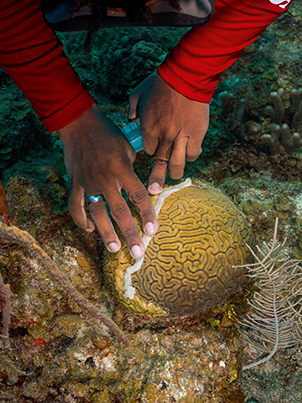-
Home
-
Data & Publications
-
Regional Portals
- About Regional Portals
- Florida
- Navassa Island
- Puerto Rico
- Flower Garden Banks
- U.S. Virgin Islands
- American Samoa
- Commonwealth of the Northern Mariana Islands
- Federated States of Micronesia
- Guam
- Main Hawaiian Islands
- Republic of the Marshall Islands
- Northwestern Hawaiian Islands
- Republic of Palau
- Pacific Remote Island Areas
-
CRCP Activities
- Glossary
Stony Coral Tissue Loss Disease

Atlantic-Caribbean coral reef ecosystems are in the midst of an unprecedented outbreak of stony coral tissue loss disease (SCTLD). Characterized by rapid spread, rapid tissue loss, and high mortality rates, SCTLD has affected corals along the entirety of Florida's Coral Reef and in 22 Caribbean countries and territories, including the U.S. Virgin Islands and Puerto Rico and the Flower Garden Banks in the Gulf of America (formerly Gulf of Mexico). SCTLD is rapidly reducing coral cover in a region already dealing with declining coral reefs. The disease's persistence in affected areas and continued spread represents one of the most important threats currently facing America's coral reefs.
Download: Prospectus for Stony Coral Tissue Loss Disease: A Present and Growing Threat to Coral Reefs
Strategy for Stony Coral Tissue Loss Disease
Download the executive summary: NOAA Strategy for Stony Coral Tissue Loss Disease Response and Prevention - Executive Summary
Download the strategy: NOAA Strategy for Stony Coral Tissue Loss Disease Response and Prevention

Stony coral tissue loss disease was first identified in 2014. In 2020, NOAA published its Strategy for Stony Coral Tissue Loss Disease Response and Prevention to help guide an agency-wide response to SCTLD. The NOAA Strategy for Stony Coral Tissue Loss Disease Response and Prevention provides a framework and focus for ongoing efforts to slow the spread of the disease across the Atlantic and Caribbean regions and to prevent and prepare for the possible spread of the disease into the Indo-Pacific region in support of resilient coastal ecosystems, communities, and economies nationwide. The strategy will build on ongoing efforts to understand, respond to, and mitigate the disease and be used to inform a national-level implementation plan.
An Implementation Plan for Response and Prevention to Stony Coral Tissue Loss Disease
Download the Executive Summary: NOAA Strategy for Stony Coral Tissue Loss Disease (SCTLD): An Implementation Plan for Response and Prevention - Executive Summary
Download the implementation plan: NOAA Strategy for Stony Coral Tissue Loss Disease (SCTLD): An Implementation Plan for Response and Prevention

As of August 2022, SCTLD has affected corals along the entirety of Florida's 360-mile long reef system and has been reported in 22 Caribbean countries and territories, including the U.S. Virgin Islands and Puerto Rico. As of September 2022, the appearance of a SCTLD-like disease was documented at Flower Garden Banks National Marine Sanctuary in the Gulf of America. The NOAA Strategy for Stony Coral Tissue Loss Disease (SCTLD): An Implementation Plan for Response and Prevention aims to:
- Build on goals and agency priorities identified in the NOAA Strategy for SCTLD Response and Prevention;
- Outline a detailed, five-year course of action for SCTLD response and prevention;
- Match agency capacity with SCTLD response needs and complement and enhance the efforts of our Partners; and,
- Highlight key actions necessary to understand and address this new threat to coral reefs over the long-term.
Recognizing that SCTLD will likely be present on U.S. coral reefs for the foreseeable future, the implementation plan also outlines key actions necessary to address this new threat over the long-term. While it is unlikely that SCTLD will be fully eradicated as a result of this implementation plan, the plan would provide major gains in terms of reducing the likelihood of further transmission; preparing vulnerable areas in the event the disease reaches them; saving priority corals in regions whose corals are being heavily impacted; and, contributing to future restoration of highly susceptible species whose populations have been devastated in many areas.
Stony Coral Tissue Loss Disease: Surveillance Guidelines for the Indo-Pacific
Download the Indo-Pacific Surveillance Guidelines

As the SCTLD outbreak unfolds in the Caribbean and potentially the Gulf of America, questions regarding how it is transmitted and concerns regarding its potential spread to the Indo-Pacific region are rising. These guidelines are for coral reef managers and field conservation practitioners and researchers in the Indo-Pacific region regarding surveillance and detection of stony coral tissue loss disease (SCTLD). SCTLD is a highly lethal and fast spreading coral disease impacting the Atlantic and Caribbean but not yet found in the Pacific. This guide is not intended to replicate the more technical guidance in existing Pacific coral disease response plans.
Related Links
- Stony Coral Tissue Loss Disease Semi-Annual Newsletter: Winter 2023 Edition
- Prospectus for Stony Coral Tissue Loss Disease: A Present and Growing Threat to Coral Reefs
- Stony Coral Tissue Loss Disease: Understanding & Preventing Disease Transmission Fact Sheet
- Gulf and Caribbean Fisheries Institute: Stony Coral Tissue Loss Disease
- Coral Heroes: The Stony Coral Tissue Loss Disease Response Team
- How Can the National Coral Reef Monitoring Program Help Inform Stony Coral Tissue Loss Disease Monitoring?
- U.S. Coral Reef Task Force Coral Disease Working Group
- Coral Reef Conservation Financial Assistance
Dana Wusinich-Mendez at dana.wusinich-mendez@noaa.gov


